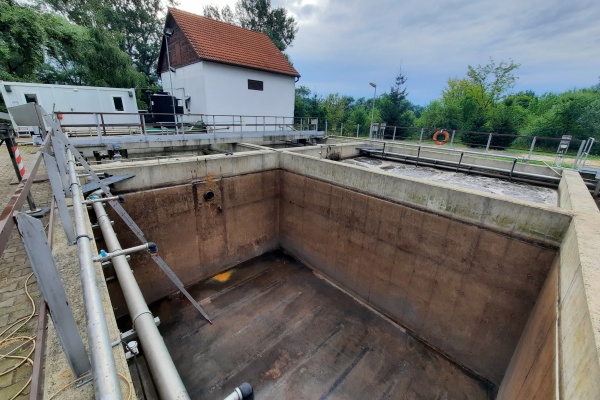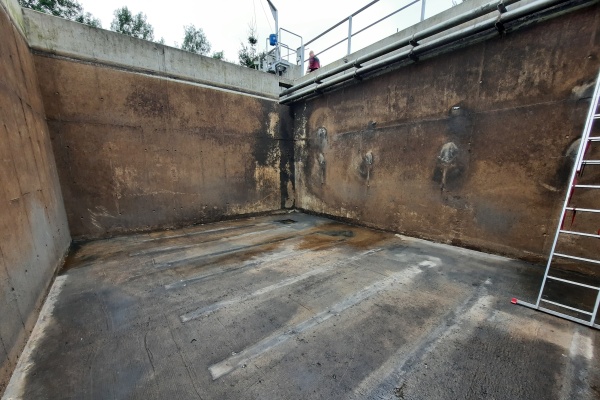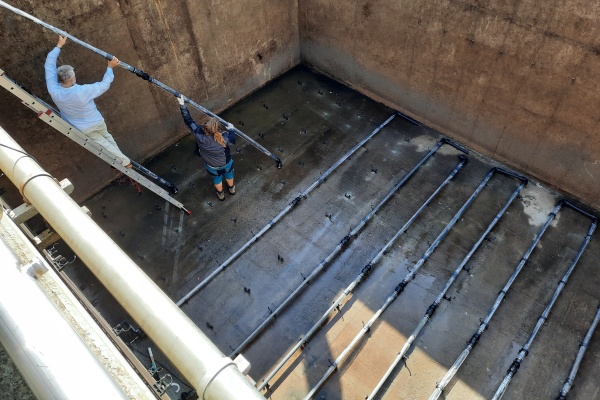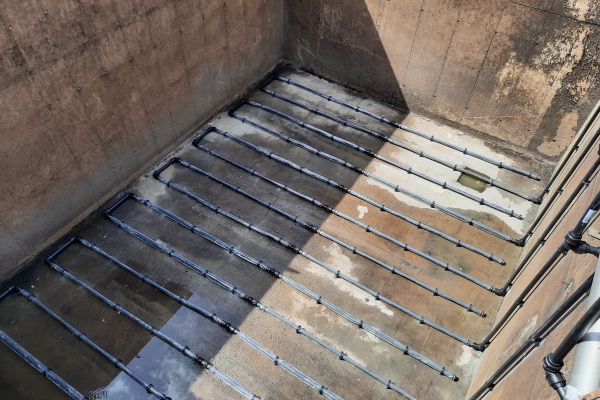Proper aeration leads to decent dewatering results

Even though our core product is the MP-DW screw press, we always strive to offer our municipal and industrial wastewater treatment plant (WWTP) customers the most complete dewatering solution possible. Because even the most powerful equipment, specially developed for efficient dewatering, will only work wonders if you start right from the beginning. Well-prepared sludge and its proper activation through aeration will lead to excellent results.
Aeration is a necessary start

After the mechanical pre-treatment of sludge on belt filters or drum screens, the biological treatment of wastewater takes place via aeration. Aeration is the process of oxygenating wastewater. Aeration creates an ideal breeding environment for aerobic bacteria, which eat up the primary sludge and dissolve organic matter, thereby purifying the water and reducing the volume of organic matter. Suppose the activation tank is not appropriately aerated. In that case, anaerobic bacteria multiply in the sludge, which also purifies the wastewater, but at a much slower rate and with a different intensity. In addition, this process produces dangerous gases such as hydrogen sulfide and ammonia, which change the pH of the water and inappropriately alter biological processes. Therefore, you need an excellent aeration technology that gets dissolved oxygen in the water into your activation tanks.
The more bubbles, the cleaner the water

Aeration aims to get the air to the bottom of the activation tank, where it is released and rises upwards, dissolving the oxygen in the water. This aerates the wastewater with the sludge. The more micro air bubbles rise to the surface, or the greater the total surface area, the more effective the aeration. We use membrane tube diffusers for this purpose.
Durable diffusers or aeration elements
For our projects, we prefer diffusers with polyurethane membranes,, which are much harder, stronger, and more durable than traditional "rubber" EPDM membranes. We achieve much better aeration than conventional membranes by making small holes in the polyurethane membranes. EPDM membranes also have another disadvantage: they age very quickly.
We use membranes from a proven Czech manufacturer and customize them for each project. This allows us to be extremely flexible. We know each customer has a different activation tank, floor plan, and oxygen quantity needs. That's why we design diffusers to be the exact optimized length.
Case study: Mutěnice

In the summer, we successfully installed an aeration system in the village of Mutěnice in South Moravia. The municipality has a wastewater treatment plant for about 4,500 EO (equivalent inhabitants) and used about 20-year-old aeration elements that no longer met today's efficiency and energy requirements. The primary objective was to replace outdated and inadequate aeration with entirely new technology.
We took part in a tender, which we won not only because of the price but, above all, because of the sophisticated technical solution. We did not want to simply replace "old with new." We aimed to offer the customer a clear added value - optimization of the entire aeration system. This means a comprehensive aeration project from the blowers to the end diffusers. Above all, to make the whole branching structure of the membrane diffusers as simple, straightforward, and efficient as possible.
Lossless aeration
We do aeration differently. We use one main pipe from which, for example, ten pipes lead to the tank, and each has its own valve. This system eliminates potential problems, e.g., if a membrane breaks, it can be shut down, and the whole system can continue to operate. In contrast, competing systems often have all the air escape through one ruptured membrane due to a single mechanical failure, thus not getting oxygen to the other membranes. Care is taken to ensure minimal pressure losses in the piping during air transfer from the compressor to the diffuser.
Even when preparing the project documentation, we make sure that we maintain a pipe cross-section that is optimal for the required amount of supply air to pass from the blower to the end diffusers. In other words, we strive for an optimum air flow rate through the duct of 8 m/s, and for larger ducts above 100 mm diameter, a maximum of 12 m/s.
Aeration results in Mutěnice
At the Mutěnice WWTP, before the reconstruction, the total pressure behind the blower was 700 mB for a deep tank of 450 cm of water, which means 250 mBar of pressure loss on the pipes and membranes alone. After the reconstruction and installation of the diffusers we supplied, there is only 500 mB, which means our total losses on the pipe and membrane are 50 mBar. This means that the pressure loss is 200 mB lower. On the blowers alone, this means an electricity saving of at least a third. It is, therefore, clear that the investment in the aeration system will pay back the municipality within a year, at most only in electricity costs.
We also received other valuable feedback from the WWTP operator in Mutěnice. The aeration conditions have significantly improved. Thanks to the fact that we have designed and implemented an even distribution of diffusers over the entire surface of the activation tank, oxygen access to the wastewater is optimal. The sludge is thus in much better condition.
Another added value of our aeration technology is the long service life - we can guarantee up to ten years. This is mainly due to our high-quality materials compared to our competitors. We use more robust couplings to attach the diffusers, and we don't use plastic dowels but stainless-steel chemical anchors that will stay in the tanks forever.
Need reliable technology to get oxygen into your wastewater? We have the solution.
We handle aeration from A to Z. We will design, manufacture, deliver, install, and put your wastewater treatment plant into operation. Contact us.


